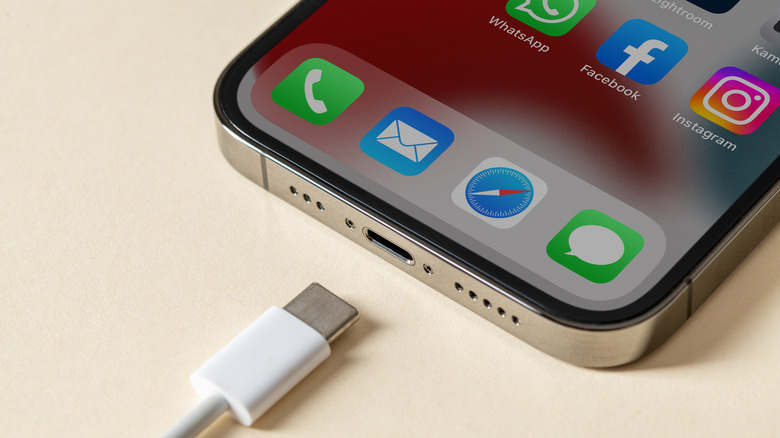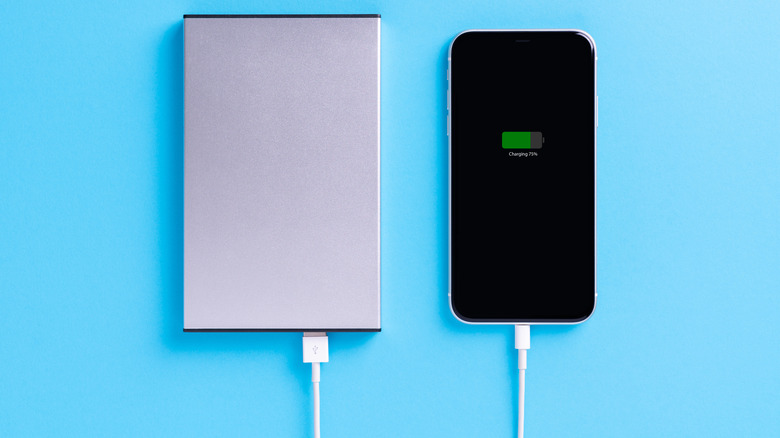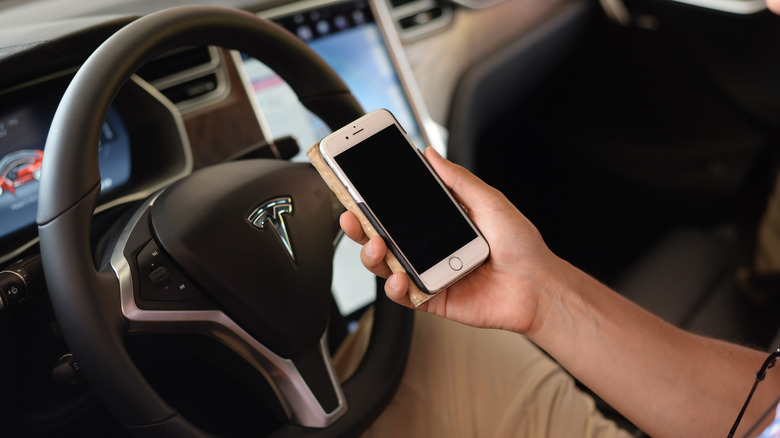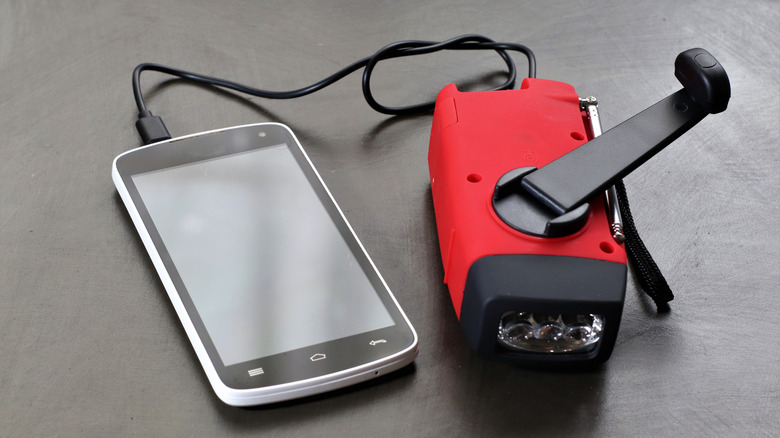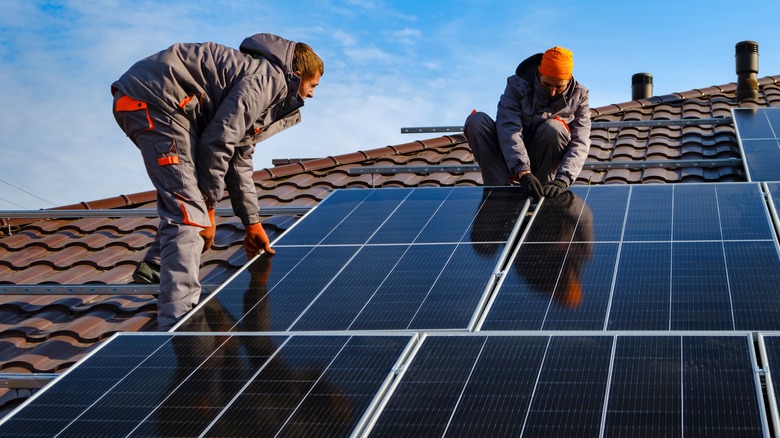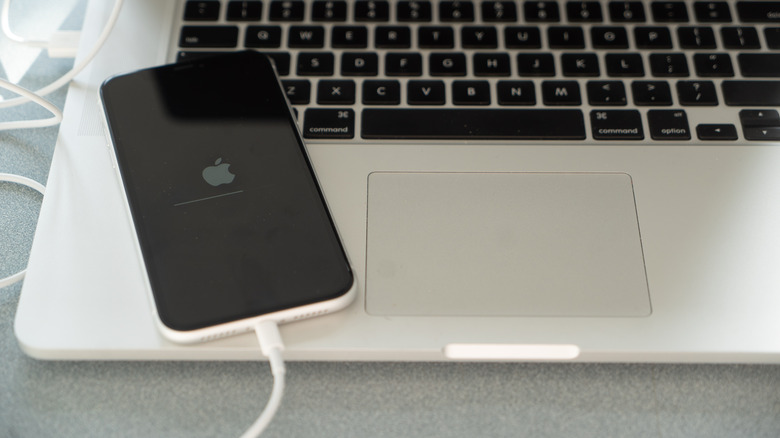How To Charge Your iPhone Without A Wall Charger
It may now feel like a distant memory, but it wasn't that long ago that charging your phone was not nearly as painless a process as it is now. Quick-charging technology has only been around for about a decade, but it's come a long way from previously standard charging speeds.
Before that, getting a completely wiped-out phone back to a usable state took a lot longer than the (roughly) 15-30 minutes it requires now. That technology has been extended to other charging solutions as well, like power banks, so getting back in working order after the iPhone battery dies is easier than it's ever been.
That includes a number of options that don't require a wall charger and an electrical outlet. Some of these options may be more familiar to the average reader, but others are a bit more outside the box and not necessarily intended specifically for smartphones, much less the iPhone in particular.
Power banks
It's the obvious solution, but it's a good one: Picking up a power bank. Power banks are simply rechargeable batteries that you can plug your phone into, hopefully for multiple charges, depending on the size of the battery bank.
Power Bank options are numerous and vary in quality, both online and in retail stores. Ideally, you want a power bank from a brand with a positive track record that supports all available quick charging standards. Additionally, you want a big enough battery to charge your phone at least three times before needing to recharge the power bank, have it weigh less than eight ounces, and has an up-to-date selection of ports that match your phone.
Brands with a history of putting out reliable power banks include Anker, RAVPower, Zendure, and Clutch. Whatever you can find in the phone accessories section at stores like Best Buy may be hit or miss, but should be fine as well — with the caveat that you're more likely to find better deals online.
Car chargers
Back in the day, the primary function of what's now the charging port in your car's dashboard was very different. For most of its existence, the port primarily powered a heating element inside its cover because it commonly served as a cigarette lighter.
It made a certain kind of sense at a time when smoking was so socially accepted that cars also featured ashtrays, but the cigarette lighter branding fell out of favor in the 1990s as smoking cigarettes was not nearly as popular or widespread.
Nowadays, the former cigarette lighter position is primarily a USB charging port or infotainment connection for phones. However, older cars can utilize chargers that simply serve a wall outlet-like adapter that plugs into a car's DC port.
Besides the brands you can already trust for power banks and wall chargers, there are also good options for DC car charging from the likes of Schosche, ZMI, and Nekteck. Just be wary of snagging any DC charger from rest stops or gas stations, as they're often cheap in price and quality.
Hand crank chargers
The above options aren't necessarily ideal in an actual emergency, even one as simple as a power outage. Your power bank could be full, but if the outage lasts long enough, the bank will be tapped dry before long. Your car isn't an infinite resource, either.
That's where alternative chargers come in, chargers that can generate their own electricity independent of a wall outlet or car charger. Not all of these are necessarily built as phone chargers, but some might list phone charging as a feature, among other emergency benefits they provide. If you live in a hurricane zone or other high-risk area, then you definitely need to consider one of these.
Perhaps the most popular are hand-crank chargers, in which turning a crank starts an electromagnetic induction process to generate electricity that is then stored in the built-in battery. To avoid constant cranking on your part, it's best to get a crank charger that includes the biggest battery that you can afford.
Your journey will probably also direct you towards a charger that also includes an AM/FM radio and a flashlight, which obviously come in handy in emergencies in their own ways. The big charging companies aren't necessarily in this space, so it's best to look for reviews from outlets you trust for this kind of charger.
Solar chargers
If the weather isn't an issue, there is another option for generating your own electricity: Solar chargers. These miniaturized versions of the solar panels placed on top of houses work the same way, utilizing what's called the photoelectric effect.
The photons in sunlight contain enough energy to get electrons moving, and voila, that becomes electricity. In scenarios like camping trips and long hikes, a solar charger makes sense as something to keep in your bag that you could rely on in a pinch.
Some of the brands mentioned above for power banks and other alternative chargers, like Anker and Nekteck, make highly rated solar chargers and solar power banks. Less-familiar brands like BigBlue, Blavor, and GoalZero also receive good reviews for solar chargers as well.
Solar chargers aren't necessarily for everyone, but for people who spend a significant amount of time in the outdoors and often have a sudden need for a charge — at least in part, if you opted for a solar bank instead of a plain solar charger — then they're well worth picking up.
Plugging your phone into your computer
What was once incredibly common is now so much less so that it may not be an immediately obvious option. There are various reasons not to charge your iPhone straight from your MacBook if you have better options, but in a pinch, a laptop may be your easiest route to a charger.
If, for example, you're on a train home from work and your computer is charged but your phone needs some help, your laptop can help bring your phone back to life. Albeit some caveats apply: Your computer's USB port delivers a lot less current than a wall outlet and charger do, so your phone will charge much slower.
For security reasons, it's also best to only use a trusted notebook like your own, and not plug into any random computer or laptop. That said, absent of any other options, it's worth a shot if you know what you're doing and are being careful.
